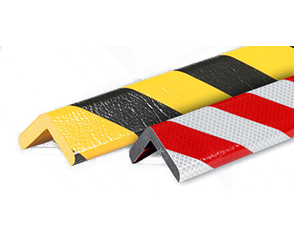Anodized Aluminum
Click below for pertinent facts and informational links for the materials that our corner guards are made from.
Our Anodized Aluminum corner guards are made from Grade 5005 clear anodized aluminum. This material looks very similar to the silver trim you see around glass panels on a storefront. These are formed in a press brake from sheets of anodized aluminum material. Material thicknesses available are .060’’, .080’’ and .125’’.
What is Anodized Aluminum?
Anodized aluminum is aluminum that has been treated to develop an exceptionally durable finish. To create anodized aluminum, you use an electrochemical process where the metal is immersed in a series of tanks, wherein one of the tanks, the anodic layer is grown from the metal itself.
Because this anodized layer is created from the aluminum itself, rather than being painted on or applied, this anodized aluminum will never chip, flake, or peel, and it is much more durable than any other similar material on the market. Anodized aluminum is three times harder than the raw material, and 60 percent lighter than other competing metals like stainless steel and copper.
More information on Anodized Aluminum
From Wikipedia: https://en.wikipedia.org/wiki/Anodizing
Anodizing is an electrolytic passivation process used to increase the thickness of the natural oxide layer on the surface of metal parts.
The process is called anodizing because the part to be treated forms the anode electrode of an electrolytic cell. Anodizing increases resistance to corrosion and wear, and provides better adhesion for paint primers and glues than bare metal does. Anodic films can also be used for several cosmetic effects, either with thick porous coatings that can absorb dyes or with thin transparent coatings that add interference effects to reflected light.
Anodizing is also used to prevent galling of threaded components and to make dielectric films for electrolytic capacitors. Anodic films are most commonly applied to protect aluminium alloys, although processes also exist for titanium, zinc, magnesium, niobium, zirconium, hafnium, and tantalum. Iron or carbon steel metal exfoliates when oxidized under neutral or alkaline micro-electrolytic conditions; i.e., the iron oxide (actually ferric hydroxide or hydrated iron oxide, also known as rust) forms by anoxic anodic pits and large cathodic surface, these pits concentrate anions such as sulfate and chloride accelerating the underlying metal to corrosion. Carbon flakes or nodules in iron or steel with high carbon content (high-carbon steel, cast iron) may cause an electrolytic potential and interfere with coating or plating. Ferrous metals are commonly anodized electrolytically in nitric acid or treatment with red fuming nitric acid to form hard black Iron(II,III) oxide. This oxide remains conformal even when plated on wiring and the wiring is bent.
Anodizing changes the microscopic texture of the surface and the crystal structure of the metal near the surface. Thick coatings are normally porous, so a sealing process is often needed to achieve corrosion resistance. Anodized aluminum surfaces, for example, are harder than aluminum but have low to moderate wear resistance that can be improved with increasing thickness or by applying suitable sealing substances. Anodic films are generally much stronger and more adherent than most types of paint and metal plating, but also more brittle. This makes them less likely to crack and peel from aging and wear, but more susceptible to cracking from thermal stress.
Does anodized aluminum wear off?
The mechanical properties of anodize are a surface condition. They make the immediate surface “Harder”, but NOT stronger. Anodize increases wear resistance by covering the surface with a material that won't wear away as easily, but it is not “stronger”. Anodize does not come off.Jan 21, 2014
What is the difference between aluminum and anodized aluminum?
Anodized aluminum is aluminum which has been oxidized so that its surface is no longer reactive. ... Anodized aluminum is still very conductive, but the surface is much harder than regular aluminum. It is much more durable than, say, a nonstick pan.
Is anodized aluminum stronger?
Anodized aluminum surfaces are harder than aluminum but have low to moderate wear resistance, although this can be improved with thickness and sealing.
How can you tell if aluminum is anodized?
Scrape a penny across an unobtrusive portion of the metal. Polished aluminum is very soft, as all natural aluminum remains. But, anodized aluminum has a surface strength harder than steel. If the penny is able to scratch the finish, the material is polished aluminum.
Will anodized aluminum fade?
Does colored anodizing fade, peel, or rub off? Following the dying of an anodized surface, a sealer is applied to effectively close the pores and prevent fading, staining, or bleeding out of color. A properly dyed and sealed component will not fade under outdoor conditions for a minimum of five years.
Is anodized aluminum dangerous?
Anodized aluminum is sealed so that the metal cannot leach into food or react with acidic foods. Unlike ordinary, lightweight aluminum pots and pans, which are highly reactive with acidic foods (like tomatoes), anodized aluminum cookware is safe. It is also non-stick, scratch-resistant and easy to clean
Is anodized aluminum rust proof?
Will Anodized Aluminum Rust? ... This electrical current oxidizes, or rusts, the surface and creates a protective film. Because of that, anodized aluminum does rust but not in a typical way, and more importantly not in a harmful way. It has increased resistance to corrosion and wear.
Is anodized aluminum magnetic?
The best answer is to say that it is not magnetic under normal circumstances. But it's always impressive to show them the can demonstration and how it can interact with magnets. We can say that in strong magnetic fields aluminum can become slightly magnetic but in everyday experience it does not exhibit magnetism.












